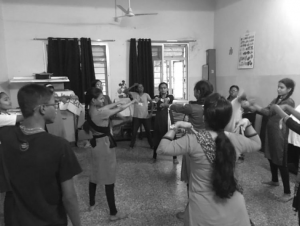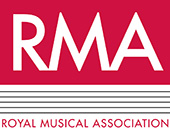Student Blog: Modelling a change: Sex Workers’ Children and Dance Pedagogy
In this month’s blog article, Mohanish Jaju explores the pedagogical strategies of Kathak dance and how the organisation Sutradhar incorporate them as part of their education and social project ‘DEED’. Mohanish Jaju is a professional Indian musician and an experienced sound designer. A former post graduate in Indian Music, he is now studying his 2nd Master’s in Ethnomusicology, at SOAS University of London. He maintains a keen interest in researching interdisciplinary music pedagogy, and music technology.
Email: mohanish.jaju@gmail.com
Linkedin: https://www.linkedin.com/in/mohanish-jaju-13a029ba
Twitter: @MohanishJaju
Modelling a change: Sex Workers’ Children and Dance Pedagogy
In this article, I will discuss the work of a women led, non-profit organisation named ‘Sutradhar’. This organisation is utilising dance as an agent of social upliftment and works with the children of sex workers who reside in the red-light areas of Pune, India. I will also be discussing the possible challenges of utilizing ‘Kathak-based pedagogy’ as an agent of social upliftment.
Kathak, the classical dance of North India, combines virtuosic footwork and dazzling spins with subtle pantomime and soft gestures. As a global practice and one of India’s cultural markers, kathak dance is often presented as heir to an ancient Hindu devotional tradition in which men called Kathakas danced and told stories in temples. The dance’s repertoire and movement vocabulary, however, tell a different story of syncretic origins and hybrid history – it is a dance that is both Muslim and Hindu, both devotional and entertaining, and both male and female. Kathak’s multiple roots can be found in rural theatre, embodied rhythmic repertoire, and courtesan performance practice, and its history is inextricable from the history of empire, colonialism, and independence in India (Walker 2014). Kathak is also linked to specific communities of Kathakars or storytellers (Morcom 2015). The traditional Kathak pedagogy in the North Indian schools of thought, is an oral tradition of knowledge transmission between the Guru (master) and Shishya (student), and is characterised by Dekho or watch, Seekho or learn, and Parkho or evaluate (Pariat 2017). During the process of learning, a student is required to travel to the Guru’s abode, memorise the compositions, and in some cases help the Guru with household errands. However, during lesson time, various techniques of body control, movement, gait, and expression are taught. Through embodiment of mudra (or characterised hand gestures), and enacting mythological stories, a student eventually learns the repertoire. This process requires 7 to 12 years of rigorous training. The founders of Sutradhar have imbibed knowledge of classical dance from their Guru Pandita Maneesha Sathe through such a process. I would argue that such a privilege of being able to dedicate time and effort in learning under an established ‘Guru’ is not accessible to many, and hence Sutradhar’s work of providing access of at least some elements of the Kathak pedagogy to the marginalised children is indeed creditable.
Under the DEED (Dance for Education, Education for Dance) initiative, Sutradhar has modelled a simplified pedagogy by blending a few elements of traditional Kathak pedagogy and Art Based Therapy (K S 2014, Guidance and Care Foundation 2019). In their bi-weekly sessions spanning twenty-four weeks, children are taught a sense of rhythm, and basic body usage. This involves tapping on a metronome, clapping to a rhythm, and learning the Hindustani Tala System – synonymous with primary level education in the traditional Kathak pedagogy. Sutradhar’s pedagogy is inspired by the body control techniques used while performing traditional Kathak compositions (like Amad, Toda, or Tukda). Therefore, fundamental exercises associated with the repertoire have been modelled into a curriculum. Since 2018, the organisation has been training a group of 50 children, aged between 6 to 16 years, and gendered equally.
Sutradhar’s major contribution to the teaching tradition of Kathak, in my opinion, would be of the student-centric teaching methodology, a paradigm shift from the Kathak Guru Shishya tradition.

DEED introduces children to the ‘nonverbal’ aspect of communication, by training them to interact with each other by using body movements and facial expressions (Aphale et al. 2018). In my experience as a Tabla accompanist for Kathak, I realised the importance of musical communication. I was trained to gauge the timing of the dancer’s spins and footwork, and translate these movements into phrases of Tabla timbres. So, if the dancer is swaying from right to left in a 6/8 time at 100 beats per minute, I would communicate her movement on the Tabla, by playing soft embellishments accentuated in 6/8 time. It would perhaps be very challenging to explain the intricate references that a Tabla player considers, but such is the non-verbal communication that occurs between the dancer and her accompanist. The ensemble that accompanies any Kathak performance comprises of vocal, percussion, and instrumental musicians. All the musicians at some point during the performance are engaged in a non-verbal communication.
I had the opportunity of working as a Tabla artist for Sutradhar’s inaugural concert in 2017, which was a showcase of Suradhar’s Talk show and a fundraiser for DEED.
Video of the concert: Watch Panchpalli from 19:26 to 22:00
I was not aware of the academic disciplines of ‘applied ethnomusicology’ or ‘music in development’ back then. So, I had not realised the importance of the DEED initiative. My ongoing course at SOAS compelled me to think about such activities is much more detail. Below I discuss some of the issues relating to Sutradhar’s development of the DEED initiative.

Sutradhar’s use of Kathak pedagogical strategies raises issues at the intersection of applied ethnomusicology, evidence-based practice and ‘subjective’ pedagogical approaches. For example, which elements define a dance as Kathak? How would these elements, which also utilise body and rhythm as in other dance forms, explicitly distinguish Kathak from any other cultural dance form? Would it not be challenging to map and reify behavioral changes, like expressive capability or confidence? And in such a case, like the DEED initiative, would it be ethical to say that it is a ‘Kathak inspired curriculum’ at all? I would argue, by drawing on Nicholas Cook’s perspective of music as product/process (Cook 2001), that Kathak is also a process and not a product. It is an ongoing process of learning, teaching, researching, composing and choreographing which then leads to a consolidated form of dance called Kathak. Hence, skills are adapted and changed through the ingenuity and innovation required in teaching to new generations (Dalidowicz 2015). This suggests that any element from this whole process, of understanding our body and embodying the art form, could be labelled as Kathak. Hence it would be ethical to call DEED’s pedagogy as ‘Kathak’ inspired. However, I would argue that in the such a process of imitating a teacher’s expressions and body language, one may become a skillful artist but may not be able to implement it in daily life. Hence, it could be a challenge to overlay bi-weekly training sessions over other daily experiences that also shape the individual’s behaviour.
Every Hindustani classical art form (Tabla, Kathak, Khayal repertoires) has a constructed ideology about its performance space, dress code, Guru Shishya relationship, philosophy of the repertoire, communication between students, and ethics of musical dialogue between co-artists. However, I would argue that such constructs could also limit the potential of the art form, if they were to be utilised as ‘agents’ beyond their constructs and sub-cultures. I would opine, as a Hindustani classical artist myself, that it would be our responsibility to raise awareness about music and dance as agencies of development. Although modelling a full-proof curriculum for behavioural change and social upliftment could probably be a challenge, I would argue that models like Sutradhar’s DEED are certainly contributing to social integration in the marginalised sector, and raising awareness about the democratic education of arts and music.
Bibliography
Aphale M and Gandhi T (2018) Sutradha DEED | Dance-based Education for
Underprivileged. Sutradhar. Available from: https://www.sutradharindia.com/sutradhar-deed
Cook N (2001) Between Process and Product: Music and/as Performance. Music Theory Online 7 (2). Available from: http://www.mtosmt.org/issues/mto.01.7.2/mto.01.7.2.cook.html.
Dalidowicz M (2015) Crafting fidelity: pedagogical creativity in kathak dance.
Journal of the Royal Anthropological Institute 21 (4): 838–854.
K S (2014) Our Previous Project. WCCLF. Available from: http://wcclf.org/ (accessed 1 May 2019).
Guidance & Care Foundation (2019). ARTS-BASED THERAPY | Available from: http://guidanceandcare.com/arts-based-therapy (accessed 6 May 2019).
Morcom A (2015) India’s Kathak Dance in Historical Perspective.
Ethnomusicology Forum 24 (2): 288–290.
Pariat J (2017) GURU-SHISHYA PARAMPARA: Transmission of tradition in Kathak and Baul. Available from: https://scholar.google.co.uk/scholar?hl=en&as_sdt=0%2C5&q=janice+pariat+guru+shishya+&btnG=
Walker M (2014). India’s Kathak Dance in Historical Perspective. London: Routledge. https://doi.org/10.4324/9781315588322

Loved the article Mohanish. I am especially interested in the transmission of dance and how it crosses borders and across cultures. I found your article really interesting and will have to also read some of the references you gave.
Great post! All the best
Great job Mohanish – I truly enjoy reading your article!